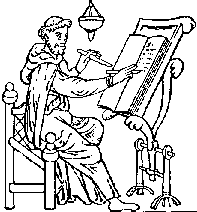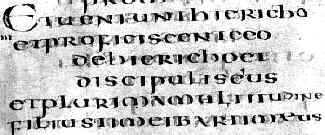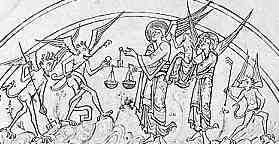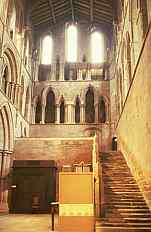





If you are looking at this page without frames, there is more information about medieval writing to be found by going to the home page (framed) or the site map (no frames).
| Monastic Scribes and Libraries | ||||
 |
After the final demise of the Roman Empire some areas retained literate culture to varying degrees. Italy, southern France, Spain and the courts of the Merovingian kings retained something of literate government and law. In other areas, like northern France, Germany and Britain, the monasteries were tiny isolated enclaves of literacy, and the monks who could write were the only scribes there were. | |||
| A good general, if somewhat elderly, book on scribes and libraries is Putnam 1962 (reprinted from 1897), while a more radical and updated scholarly view of the early part of the story can be found in Bischoff 1994. | ||||
| The initial preoccupation of these monastic scribes was to produce the tools of the trade, the works of liturgy and patristic literature which would allow them to carry out their practice of worship, Christian conversion and teaching. The books were precious and few, and were lugged across many hundreds of miles to be copied. Some books were given from centres like Rome so that newly founded monasteries had something to start with. Others were lent for the purpose. The survival of these early works is erratic, and it is hardly surprising that those that do survive tend to be the precious and valued luxury volumes rather than the everyday service books which were probably used until they practically disintegrated. | ||||
 |
This segment is from a 6th century Italian gospel which was known to be in France by the 9th century (British Library, Harley 1775, f.195). By permission of the British Library. | |||
| The preservation and copying of Latin literature in the monasteries was a somewhat erratic process in these earliest times. Enclaves of Christianity were mined for works to copy in far distant places. Every work which survives must have an unbroken pedigree of transcription back to its author, but the fact that many times more books have been lost to various causes than have survived makes tracing that pedigree difficult. A work might be discovered in a remote monastic library, copied multiple times and each copy recopied down the chain, only for most to be lost over the centuries and only the most tenuous threads able to be established. Any works which still survive today in any form were never fully lost, although they may have been mislaid for centuries before being rediscovered by another generation of scribes. | ||||
| Two areas where early Christian literature was produced became largely lost to the Christian world, Africa and Spain. Africa produced St Augustine, whose De Civitate Dei was supposed to be a Christian allegory based on the demise of the civilised Roman world. It also had a flourishing scribal culture. Books from Africa found their way into European libraries before the Arab conquests of the 7th century. |
 |
|||
| Image of the weighing of souls from a late 11th or 12th century copy of St Augustine's De Civitate Dei (Florence, Biblioteca Mediceo-Laurenziana MS XII 17, f.1v). (From New Palaeogtraphical Society 1908) | ||||
| After the Moslem conquest of Spain, Christianity survived in the far north and dotted around Mozarabic communities in the otherwise Islamic regions. However, it was not the centre of scribal culture it had been in the days of Isidore of Seville, whose works were rapidly copied and circulated around Christian Europe. Literate Spanish monks emigrated to other centres where the local influence of their Visigothic minuscule script can be detected by those with trained eyes. | ||||
 |
||||
| A litle grab from an 8th century copy of Isidore's Etymologiae, originating from the monastery of Bobbio and produced in an early Italian minuscule script (Milan, Biblioteca Ambrosiana, L.99, parte superiore, p.35). (From Steffens 1929) | ||||
| Two 6th century Italian monasteries are credited with the establishment of the culture of literate Latin scholarship and the preservation of works of the Latin Classics within the church after the demise of the Roman Empire. The former public servant Cassiodorus established the monastery Vivarium in southern Italy when he was quite old, and set up the task of copying the works of a culture becoming disregarded in turbulent times. St Benedict founded his monastery at Montecassino, which included among the daily tasks prescribed for the monks, the transcription of works in Latin. These monasteries founded a tradition of literate scholarship which was carried through Benedictine monasteries during the whole course of the middle ages, and was particularly significant in re-establishing Latin literacy in the early middle ages. The monastery of Cassiodorus was not Benedictine, having been founded before that of Benedict himself, but was based on similar principles of communal living, worship and study. | ||||
| These early centres did everything for themselves in relation to book production, including providing authors. While the monks of Vivarium and Montecassino were assiduously copying, both Cassiodorus and Benedict were becoming authors in their own right. Benedict is, of course, most famous for the Rule of St Benedict, the document which became the model and aspiration for western monasticism throught the middle ages, and which was copied and recopied countless times for the use of generations of monks. |
 |
|||
| The Rule of St Benedict was responsible for the standard layout of all Benedictine monasteries. The night stairs, as shown here from Hexham Abbey, led from the dormitory through the south transept of the church so that the night office could be observed according to the rule. | ||||
| The works of Cassiodorus can be found on the Cassiodorus website. | ||||
| The earliest works brought to these newly developing centres of Christianity, or transcribed in them by local monks being trained in the new twin arts of Christian worship and literacy, were produced in laborious scripts like uncial or half uncial, frequently in a continuous row of letters with no punctuation or word spacing. Whether in single or double columns, the text presents as a continuous block of letters. The concept of written literacy involved converting the spoken word into a simple coded string of phonetic symbols. Reading literacy involved tracking along this linear code, most likely reading slowly, aloud and remembering a good proportion of the text by heart. Many of these early scribes may have been simple and literal copyists. | ||||
 |
||||
| This is a sample from the writings of St Hilarius of Poitiers, dating from 509-10 AD (Rome, Archivio di S. Pietro, D.182). (From Steffens 1929) | ||||
| The half uncial script of the above example largely runs continuously, without punctuation or word breaks. | ||||
| It is probably a fair surmise that in the early days of the re-establishment of Christianity, many of the expanding fraternity of monks may have been more expert oral practitioners of their art than literate. After all, monastic culture has a large oral component with the daily recitation of divine office, and Christian conversion involved oral teaching of the illiterate. However, as Christian culture developed, it became the centre of Latin literacy and scholarship. The development of an advanced scribal culture and the establishment of libraries put the monasteries at the head of a chain of educational and scholarly thinking that remains unbroken, if not unaltered, up until today. | ||||
|
|
||||
|
|
||||
|
If you are looking at this page without frames, there is more information about medieval writing to be found by going to the home page (framed) or the site map (no frames). |
||||